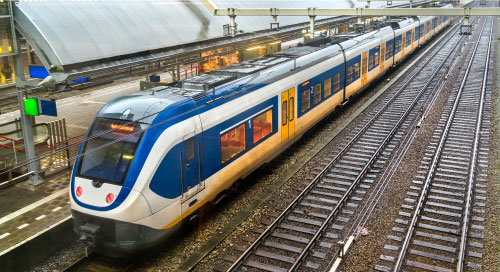Smart Rail Technology Keeps Trains Safe

Everybody wants the trains to run on time, but more important than keeping to a tight schedule is traveling without incident. And to do so, you need to be collecting real-time information from outside a train as it rolls down the tracks. This level of insight is critical to being able to alert train operators and drivers of any issues so that they can make intelligent decisions and avoid what could be potential catastrophes.
If there’s a problem up ahead, the faster the engineer knows about it, the faster they can apply the train brakes and stop. Even a split second can make a difference between disaster and getting the passengers safely to their destination.
Thankfully, with the use of artificial intelligence in transportation and 5G connectivity, data has never been more readily available. There are two types of data systems in specific that are critical to keeping railroad operations on track: Automatic Train Protection (ATP) and pantograph monitoring systems.
An ATP system is designed to continuously check how fast a train travels against the allowable speed along any stretch of track. Pantograph monitoring can sense unusual vibrations and capture video of sparks, among other issues around the train.
Getting AI in Transportation on the Right Track
One example of this is a rail system in Taiwan. The system recently started using AI and 5G for real-time ATP and pantograph monitoring, using hardware technology from MiTAC Computing Technology Corporation (MCT), which has developed a railway-focused solution—the MiAIOT Train Protecting Monitoring System (MTPMS)—based on its AI platform MiAIOT.
“With the solution, train drivers get help from new detection and alert technologies. Once there is an equipment failure, drivers no longer need to download and check the pantograph video when they get back to the train office. Instead, videos are transferred by the 5G channel,” says Russell Lo, Marketing Manager of MiTAC Information Technology Corp.
With the use of #ArtificialIntelligence in transportation and #5G connectivity, #data has never been more readily available. @MitacComputing via @insightdottech
This can accelerate delivery of information to train drivers by up to 98%, allowing them to handle alerts properly and more efficiently, Lo explains.
MTPMS transmits information not only to the driver but also the railway control center and operation rooms, thus combining information that previously was available in different streams and required more work and time to put together.
“It makes previously scattered information readable and synchronized, and improves the overall efficiency and safety of railway transportation,” says Lo.
Besides safety data, the system handles schedules and logs. “Drivers no longer need to carry USB media with the schedule when they get to the train or carry back the same USB that stores the log data from the train when they’re back. Instead, all data is transferred by the 5G channel,” says Lo.
So far, MTPMS has seen positive results when used in the Taiwan Railway Hsinchu Locomotive Depot and is expected to be expanded to Taiwan’s entire railway system, according to Lo.
Developing AI Safety Solutions
Providing an AI safety solution for trains has been a natural fit for MiTAC. The company has a long history in the IT industry, providing hardware and software solutions, systems integration services, and—through its distribution arm, Synnex—logistics and fulfillment. Around 2016 is when the company decided to make a significant investment in AI.
Its Artificial Intelligence of Things (AIOT) solutions like MiAIOT are already available to a wide range of industries, such as smart cities and government, transportation, education, security, enterprise, and manufacturing. The MiAIOT platform has even been used in various settings, including preventing the spread of disease by mosquitoes, illegal event, water resource management, and tourism.
The platform leverages seven main systems—data storage, real-time streaming, AI analysis, visualization toolkits, API, platform management, and alarm notification—to convert non-standardized data from different systems to a standard format to deliver actionable insights.
“MiAIOT is a powerful and yet simple tool that provides governments and enterprises with the insight to make the informed decisions for municipal administration, city construction, process control, asset management, and even epidemic prevention,” Lo says.
For example, leveraging MiAIOT in its MTPMS enabled the solution to predict eight train system failures about two minutes before they occurred just in the third quarter of 2022—making it possible for train operators to take immediate action, Lo explains.
The Future of AI Management
Besides expanding the use of MTPMS in Taiwan, MiTAC has other plans. Among them is a plan to offer monitoring capabilities inside train cars for safety purposes.
MiTAC eventually hopes to offer its AI technology to railway systems outside Taiwan. To do so, MiTAC plans to leverage its partnership with Intel, which would help improve the ongoing global digital transformation, Lo says.
The key to having a successful digital transformation and eliminating data silo problems is to have a unified platform where data can be allocated, aggregated, and integrated across enterprise departments, vendors, and customers, Lo explains. To make that possible, Intel is helping MiTAC develop edge-to-cloud solutions by taking out some of the complexity involved in the process and providing streamlined workflows and accelerated deployment.
Specifically for MTPMS, MiTAC plans to continue refining its AI technology to make it more predictive, giving railway operators real-time data to improve the safety of their trains and the people who ride them.
This article was edited by Christina Cardoza, Associate Editorial Director for insight.tech.